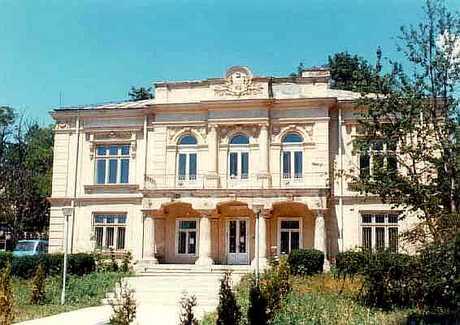Pogor House , Iasi , Romania
The Pogor House Literary Museum , Vasile Pogor's 1850s mansion, is where meetings of the literary society were held from 1871. On its lovely grounds stand rows of busts of some of the more eminent members of the society, including dramatist Ion Luca Caragiale (1852–1912) and poet Vasile Alecsandri (1821–90).
Casa Pogor has a rich history linked to Iasi’s cultural life, used as a meeting place for the city’s intellectuals, the headquarters of the Literary Society “Junimea” (1863) and of the “Literary Interlocutions” magazine (1867). It houses the Romanian Literature Museum in Iasi. The edifice was built in 1850 by the High Steward Vasile Pogor and his wife, Zoe.
Even in the heart of Iasi, before starting to climb the hill Copou Eminescu's lime among tall trees and surrounded by the vestiges of historical resonance, private courtyard wall belonging to Voda Lapusneanu-house perspective opens Pogor junimist Basil. Besides the memorial value, this building was built in 1855-1858, shows the importance and the fact that she is among the first private homes where electric lighting was introduced in the U.S., hence the name of "house with lighted windows."
The main entrance of the building is marked by a long platform under a peristyle with four Tuscan columns, above which adorn the second floor balcony ionic semicolons. An elegant frontispiece, decorated in relief with vegetal ornaments, crowns the main facade of the building.
Date of construction is attested by a hexagonal stone inscription found in the following restoration in Cyrillic: "Basil Pogor 1850 and his wife Zoe." Museum, inaugurated on 26 December 1972, has an endowment of 20,000 pieces covering the great age of classical and contemporary Romanian literature.
In the ten rooms meet objects that belonged to well-known personalities such as Iasi: Eminescu's gold watch with his monogram, gold ring with ruby stone, a piece of furniture that comes from Mihail Kogalniceanu, a set of travel and correspondence of Costache Negri, the picture "if the head" by G. Asachi Duiliu Zamfirescu's piano. Rooms are decorated with fabric of the nineteenth century, worked in Vienna Piano Steinway, Crystal Mirror, owned by IL Caragiale.
Nichita Stanescu wrote in the Book of Honor museum on Vasile Pogor House as "the place where Miorita became Ode in ancient meter." The bill their neoclassical architecture, all these noble houses in the area keeps Copou still unspoiled, picturesque old urban framework.
The 'Vasile Pogor' House is the headquarters of the museum of the modern and contemporary Romanian literature, especially the period of the great classics, of the literary society 'Junimea'. The house was built in 1850 by the high official Vasile Pogor together with his wife Zoe. This date is written on a hexagonal stone found after the diggings carried out for restoration, where the Cyrillic letters legend reads: 'V. Pogor 1850 and his wife Zoe'. The building has a rich long history connected to the Iasi cultural life as it is a place where the intellectuality of the city used to meet, the headquarters of the literary society 'Junimea' (1863) and of the review 'Literary Discussions' (1867). Among the famous personalities who used to attend the Junimea society we first remind the five founders: Titu Maiorescu, Vasile Pogor, P. P. Carp, Th. Rosetti, Jacob Negruzzi, then Mihai Eminescu, Ion Creanga, I. L. Caragiale, Ion Slavici, Vasile Alecsandri, Vasile Conta, A. D. Xenopol, N. Gane, a.s.o.
The museum was inaugurated on the 26th of December 1972. The museum itself is made up of twelve rooms of the permanent exhibition and an adjoining building inaugurated in 1994, supposed to protect the entrance to the Pogor House catacombs, restored between 1993 and 1994. They comprise corridors with two-storey ramifications (dating from the 18th and 19th centuries). Here functioned the so-called cultural club 'Junimea', which houses the activities organised by the Iasi Romanian Literature Museum: conferences during the evenings of the review 'Literary Dacia' (reissued by the Iasi Romanian Literature Museum), the literary society 'Junimea', workshops, anniversaries, commemorations of the Romanian cultural personalities, meetings with Romanian or foreign writers, presentations, book and literary reviews launching, music shows, art exhibition inaugurations.
Vasile Pogor sold the building and its surrounding park to Maria Moruzzi Cuza, mother of the future historian Gh. I. Bratianu (son of prime minister I. I. C. Bratianu, maker of the Great Unification of the Romanian States after world war one and disciple of N. Iorga). After 1906 the house has undergone some changes. After world war two the building functioned as headquarters for various institutions, then it was restored to house the Literature Museum.
The first part of the museum tackles the personalities of the two great owners of the house: Vasile Pogor, Junimea member and Gh. Bratianu, a historian and politician. Then there is the illustration of the beginnings of modern Romanian literature. Among the precious exhibits we remind: ' The Chronicle of the Moldavian Country' by Nicolae Costin, copied by Al. Beldiman, 1825; 'Heniada' by Voltaire, translated by Vasile Pogor (the high official), Bucharest, 1838; 'The Grammar' by I. Vacarescu, Vienna, 1787; 'Luck's Pawn' translated by Lazar Asachi (father of scholar Gh. Asachi), Iasi, 1816.
The hall 'Junimea' reconstitutes the Junimea atmosphere from the age of the meetings in V. Pogor's house, between 1863 and 1885 and displays the original epoch objects belonging to the Junimea members: T. Maiorescu, Jacob Negruzzi, I. M. Melik, Nicolae Culianu, Duiliu Zamfirescu. We should mention: tapestry from the 19th century, made in Vienna, 'Steinway' piano, crystal mirror from the 19th century belonging to I. L. Caragiale.
The last section of the museum is dedicated to the Romanian literature of Bessarabia and Bukovina, then the contemporary one, represented iconographically, with rare issues, original manuscripts and objects belonging to the writers. Since 1994 the museum building has been under restoration. The permanent exhibition will undergo a new reorganisation, and the museum will reenter the Iasi museum circuit by 1998.




